I went to the world's oldest restaurant, first documented in 803. It's enchanting yet eerie, and I had one of the best meals of my life.
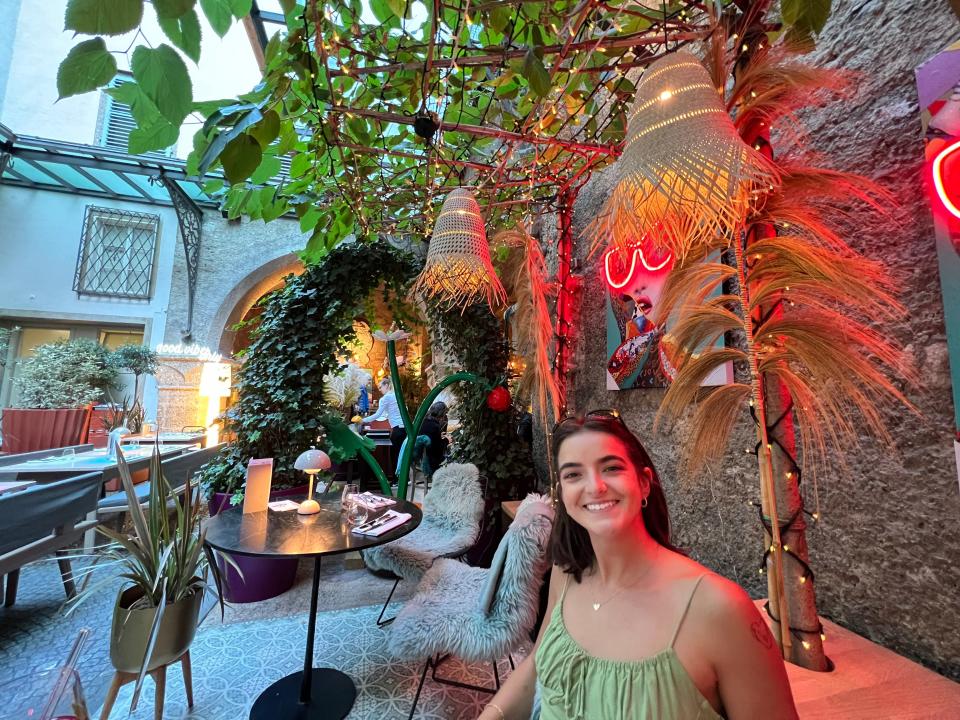
I ate at the world's oldest restaurant, St. Peter Stiftskulinarium, in Salzburg, Austria.
First documented in 803, past diners include Christopher Columbus and Wolfgang Amadeus Mozart.
I like it so much, I've been twice, and think it's an unforgettable experience with incredible food.
St. Peter Stiftskulinarium is famous for being the oldest restaurant in the world. While visiting Salzburg, locals persuaded me to try it, and it's become one of my favorite restaurants.
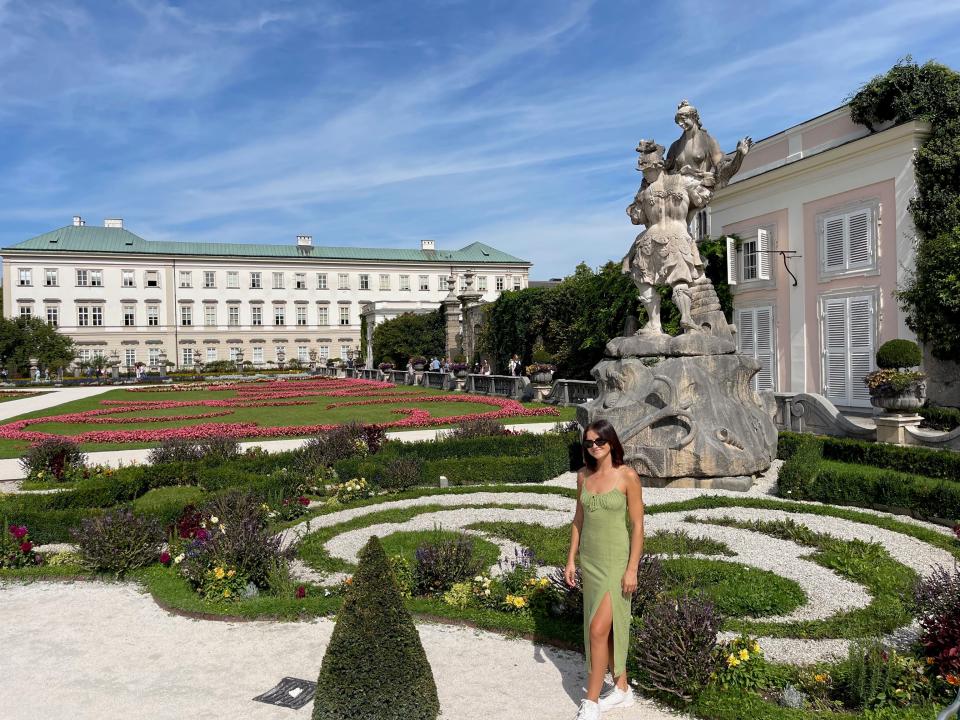
One of my favorite restaurants in the world also happens to be the oldest.
The 1,200-year-old St. Peter Stiftskulinarium in Salzburg, Austria, was first documented in a letter to Charlemagne, known as the father of Europe, in 803 and I've been lucky enough to eat here twice.
I didn't know St. Peter Stiftskulinarium existed before my first trip to Salzburg, and only learned about it from locals I asked for food recommendations. They raved about it and shared its fascinating history. I knew I had to experience it for myself.
While Sobrino de Botín in Madrid holds the record for the oldest, continuously-running restaurant in the world, St. Peter Stiftskulinarium is actually older.
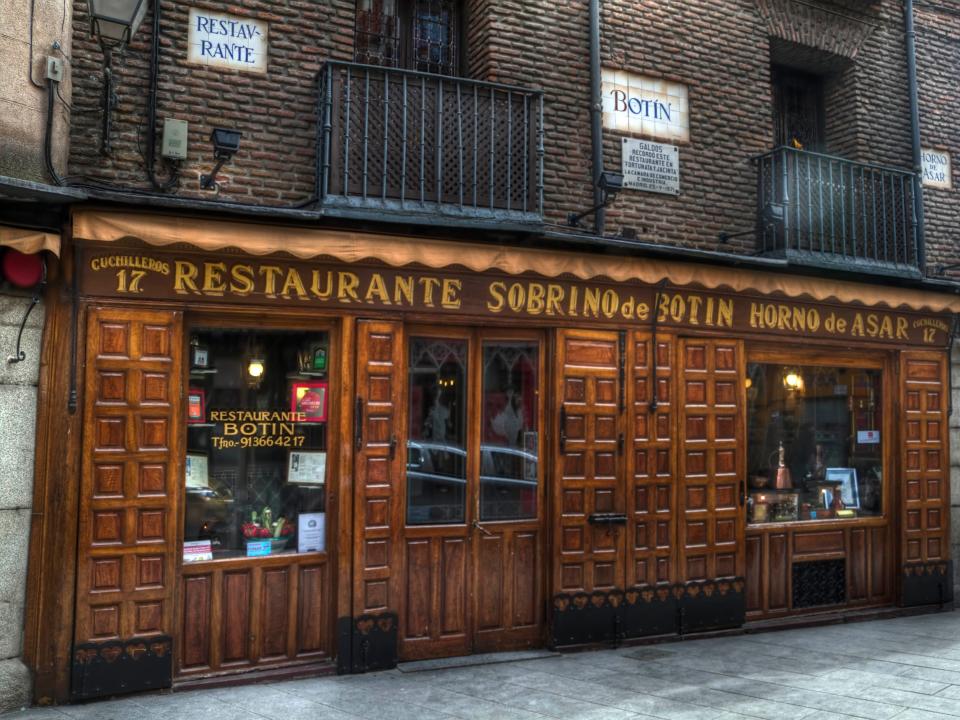
Sobrino de Botín in Madrid is the oldest, continuously-running restaurant in the world, but St. Peter Stiftskulinarium is actually older. It just doesn't hold this title because it was forced to close a few times throughout its history.
French troops, for example, were given quarters here during the Napoleonic wars. Nevertheless, St. Peter Stiftskulinarium opened 922 years before Sobrino de Botín and therefore boasts the earliest opening date of any restaurant in the world.
The grounds surrounding St. Peter Stiftskulinarum are even older than the restaurant.
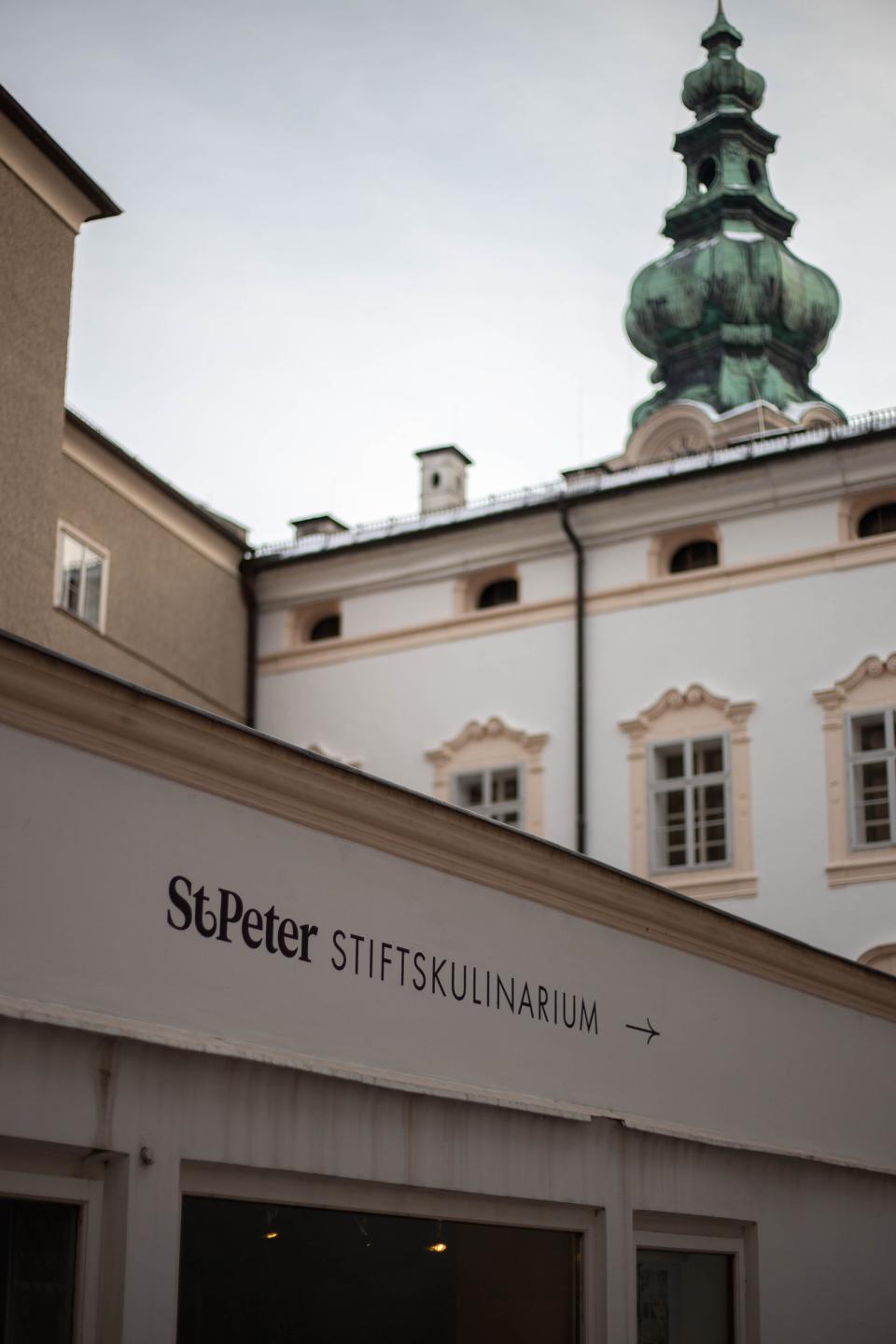
St. Peter Stiftskulinarum is located within the walls of St. Peter's Abbey, which was built into the Mönchsberg, a mountain in the city's center.
St. Peter Stiftskulinarium was both a restaurant and an inn at the time of its inception, and the neighborhood around St. Peter's Abbey is the oldest quarter in Salzburg today.
I've always been fascinated by the restaurant's history, which is cloaked in legend.
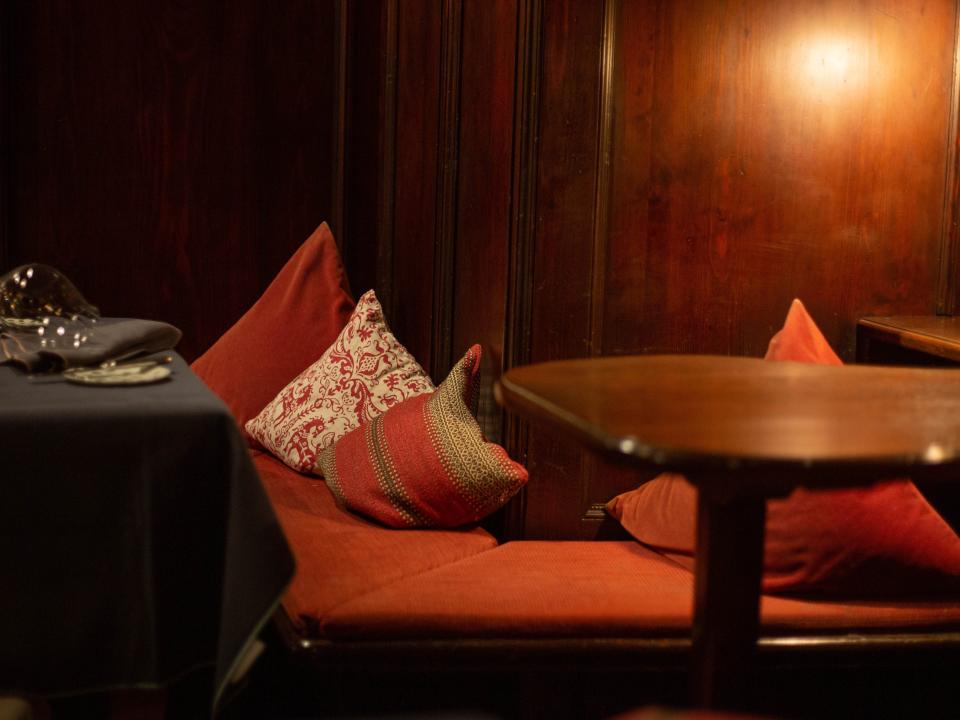
It is said that Christopher Columbus, Johann Georg Faust, and Wolfgang Amadeus Mozart were patrons of St. Peter Stiftskulinarum. It has also served cardinals, bishops, princes, kings, and in more modern times, Bill Clinton, Clint Eastwood, and many others. Locals told me that the president of Austria and other European political figures dine here as well.
As I learned more about the restaurant's storied past, I found much of its legacy is cloaked in legend.
For example, St. Peter Stiftskulinarium didn't always accept money in exchange for food when it first opened. It was customary to serve food to religious travelers, who would often stay and help at the monastery while passing through.
And Wolfgang Amadeus Mozart's sister, Nannerl, wrote in her diary in 1786 that their family met here for dinner.
Michael Haydn, a famous composer, also lived and performed music in the "Haydn Room," which is located next to the Baroque Hall. Baroque Hall is a candle-lit concert hall in St. Peter's Stiftskulinarium where special event Mozart dinner concerts are held today.
Today, St. Peter Stiftskulinarium is a hip, upscale restaurant that serves both traditional Austrian dishes and modern cuisine.
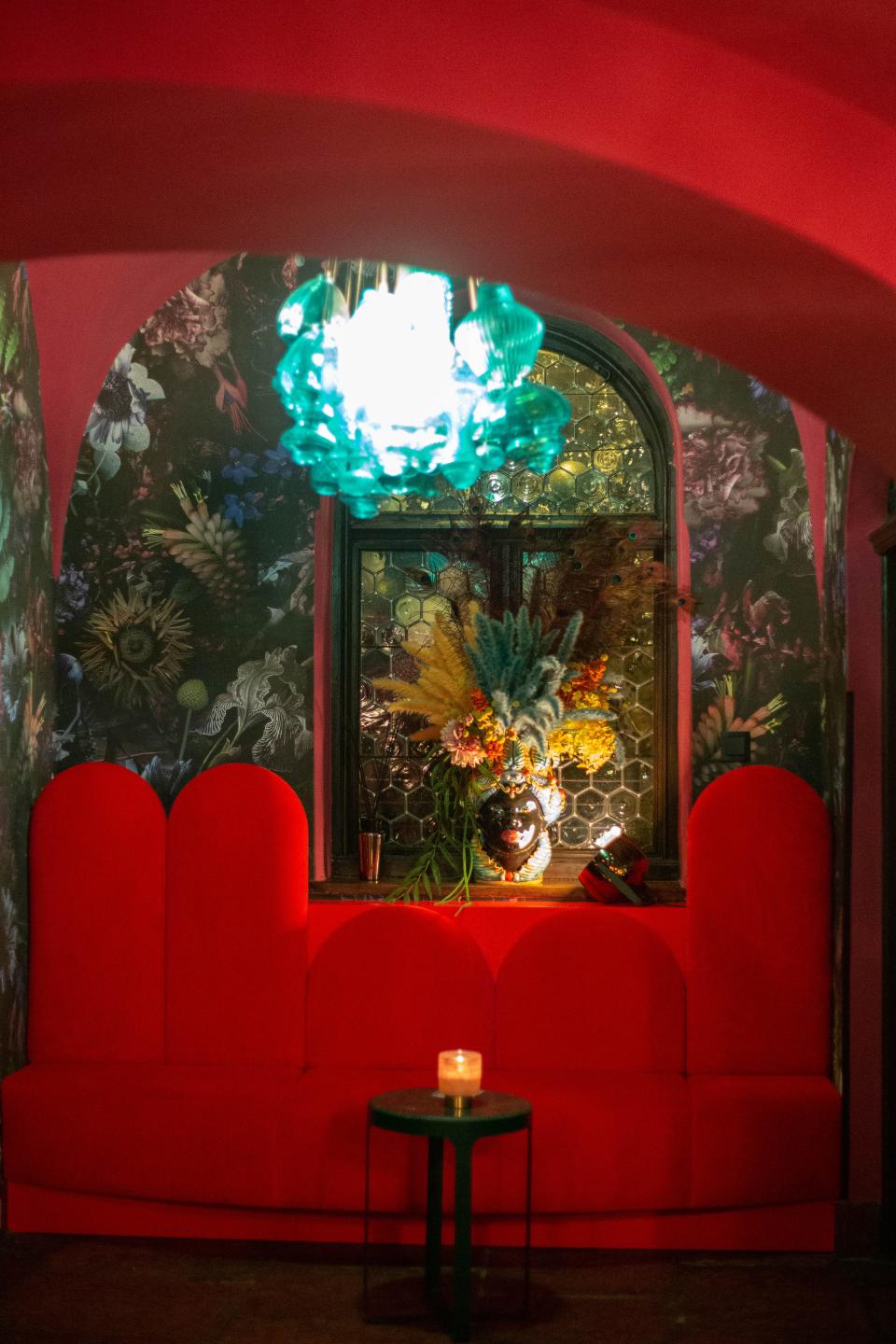
Today, St. Peter Stiftskulinarium is known for its significant history and past clientele, as well as traditional, yet modern Austrian cuisine.
The regular menu includes a variety of dishes like steak, pasta, venison, beef, chicken, duck, and seafood, as well as vegetarian and vegan options.
Dinner prices are between €22 and €49. There is a second menu for multi-course meals. These luxury dining experiences range from €62 to €153.
From dining here I've learned that their most popular traditional dish is Tafelspitz, beef boiled in a broth that's served with creamed spinach, minced apples, and horseradish. Other popular Austrian dishes include wiener schnitzel, Marillenknoedel (apricot dumplings), and Salzburger Nockerln, which is a meringue-like dessert made with eggs and sugar.
On my most recent trip to St. Peter Stiftskulinarium, I made a reservation a week before I arrived in Salzburg.
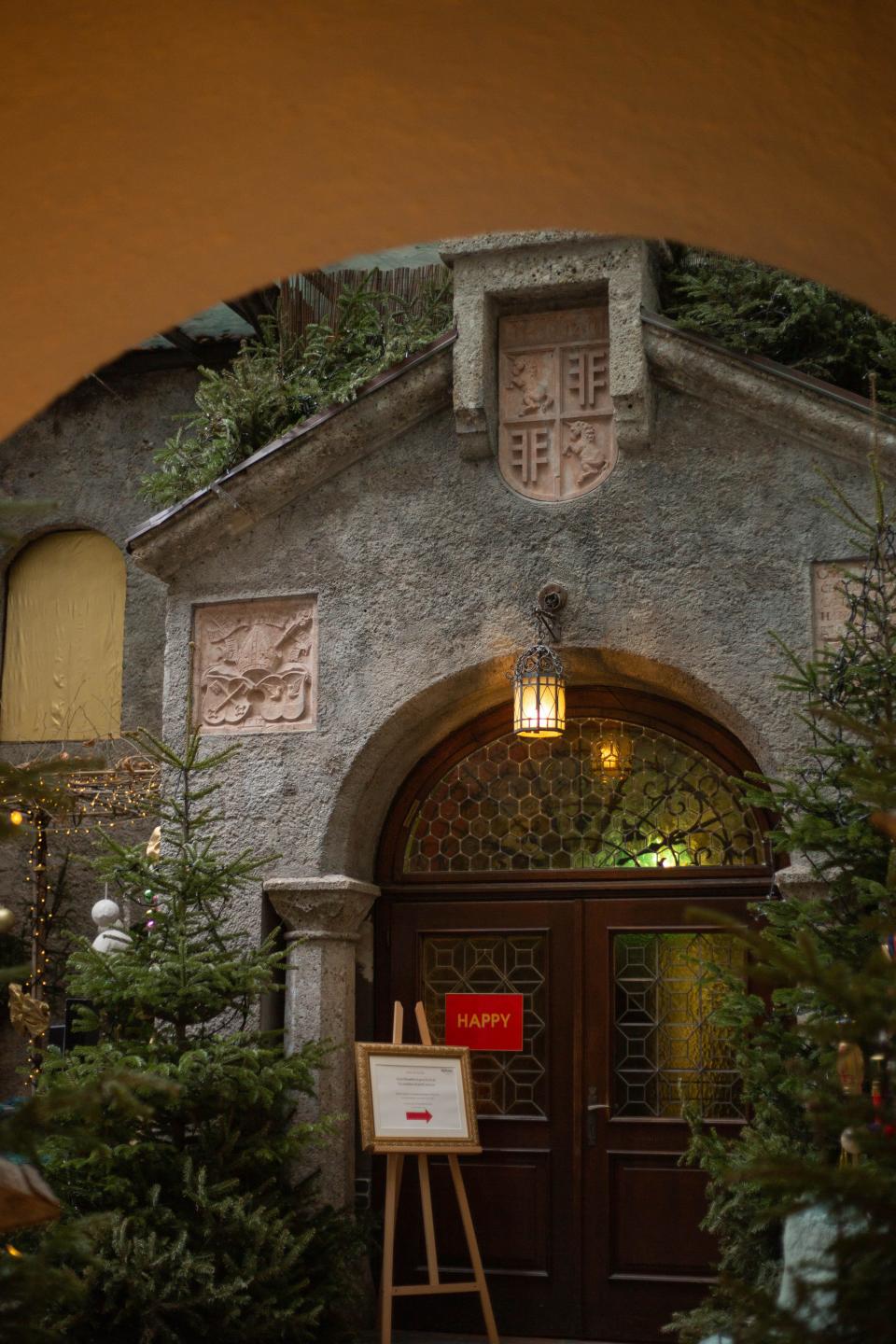
I've been to Salzburg twice and dined at St. Peter Stiftskulinarium once during each trip.
My most recent trip to Salzburg was this past winter. I was there for five days, and I made a reservation a week before I arrived.
I was eager to return to St. Peter Stiftskulinarium after the great experience I had the first time, which was in the fall.
I was excited to be within its incredible atmosphere again, eat delicious food, and further explore the sense of mystery I felt while dining in this legendary establishment.
Getting a reservation at the oldest restaurant in the world isn't as hard as you might think.
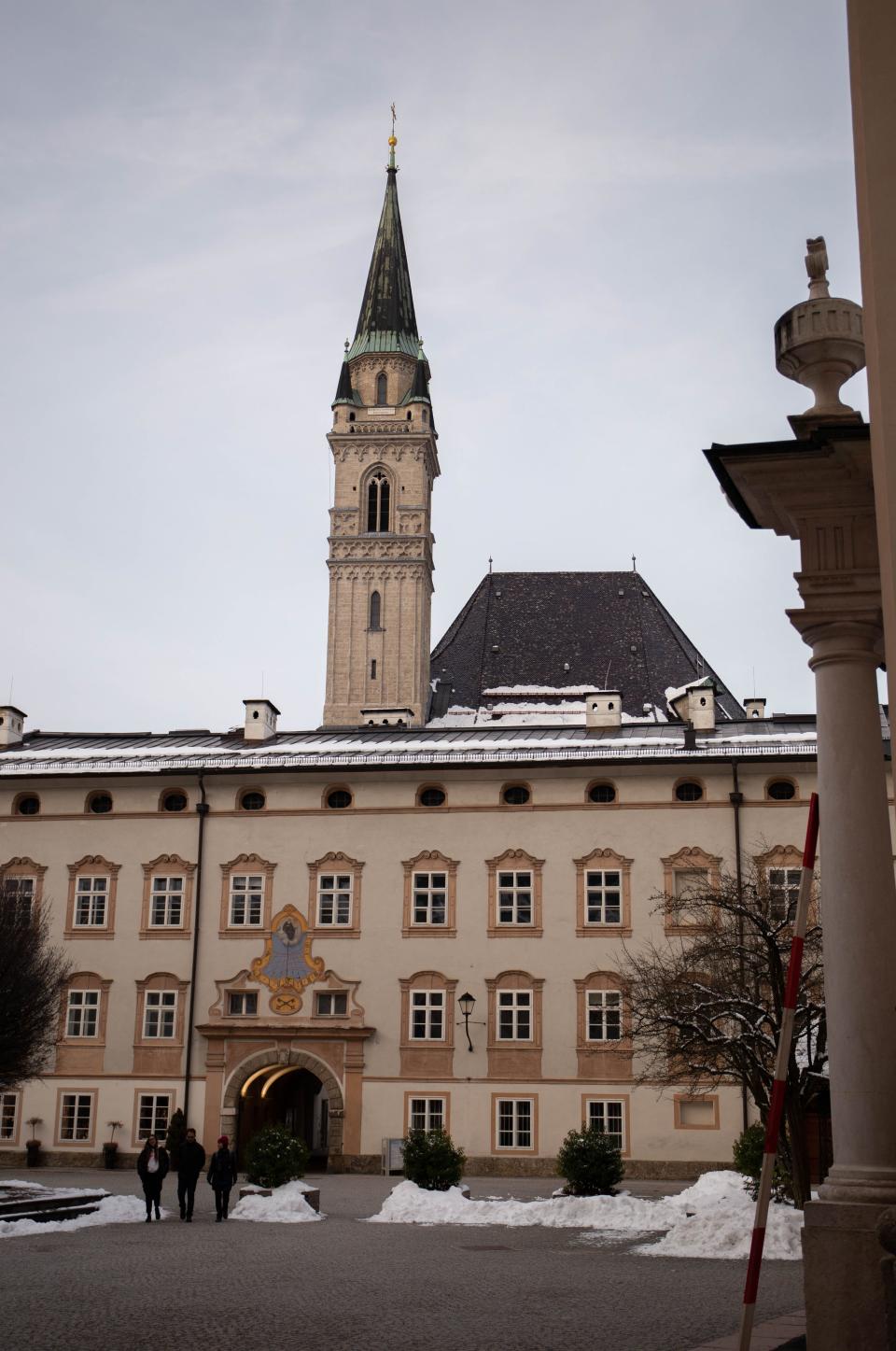
In my experience, getting a reservation is surprisingly easy, likely because the restaurant can seat 620 people.
Restaurant staff did tell me, however, me that weekend brunch reservations tend to fill up fairly quickly.
When making a reservation, I was told that it's not possible to make requests to sit in specific rooms, but it's permitted to explore the restaurant regardless of where you dine.
To get to the restaurant from my hotel, I had to cross the Makartsteg, a bridge over the Salzach River with beautiful views of Salzburg's Old Town.
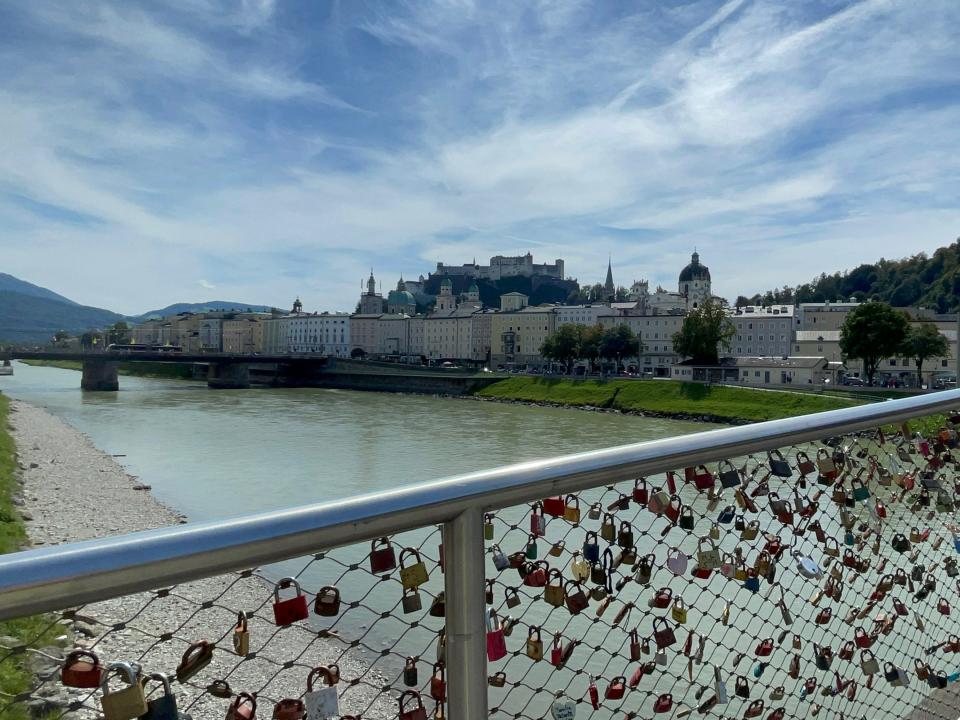
In my opinion, Salzburg is an amazing and underrated city. It's relatively small and I think it can be explored in one to two days.
During my trip to Salzburg this past winter, I stayed in Neustadt, which is Salzburg's New Town.
St. Peter Stiftskulinarium is in Salzburg's Old Town, so I just had to cross the bridge to get there.
I thought the views across the water were beautiful, and the walk throughout Old Town was picturesque. The cobblestone streets felt intimate and storybook-like, lined with atmospheric shops, eateries, and residences.
St. Peter Stiftskulinarium isn't visible from the streets of Salzburg, which I think makes it seem secretive and exclusive.
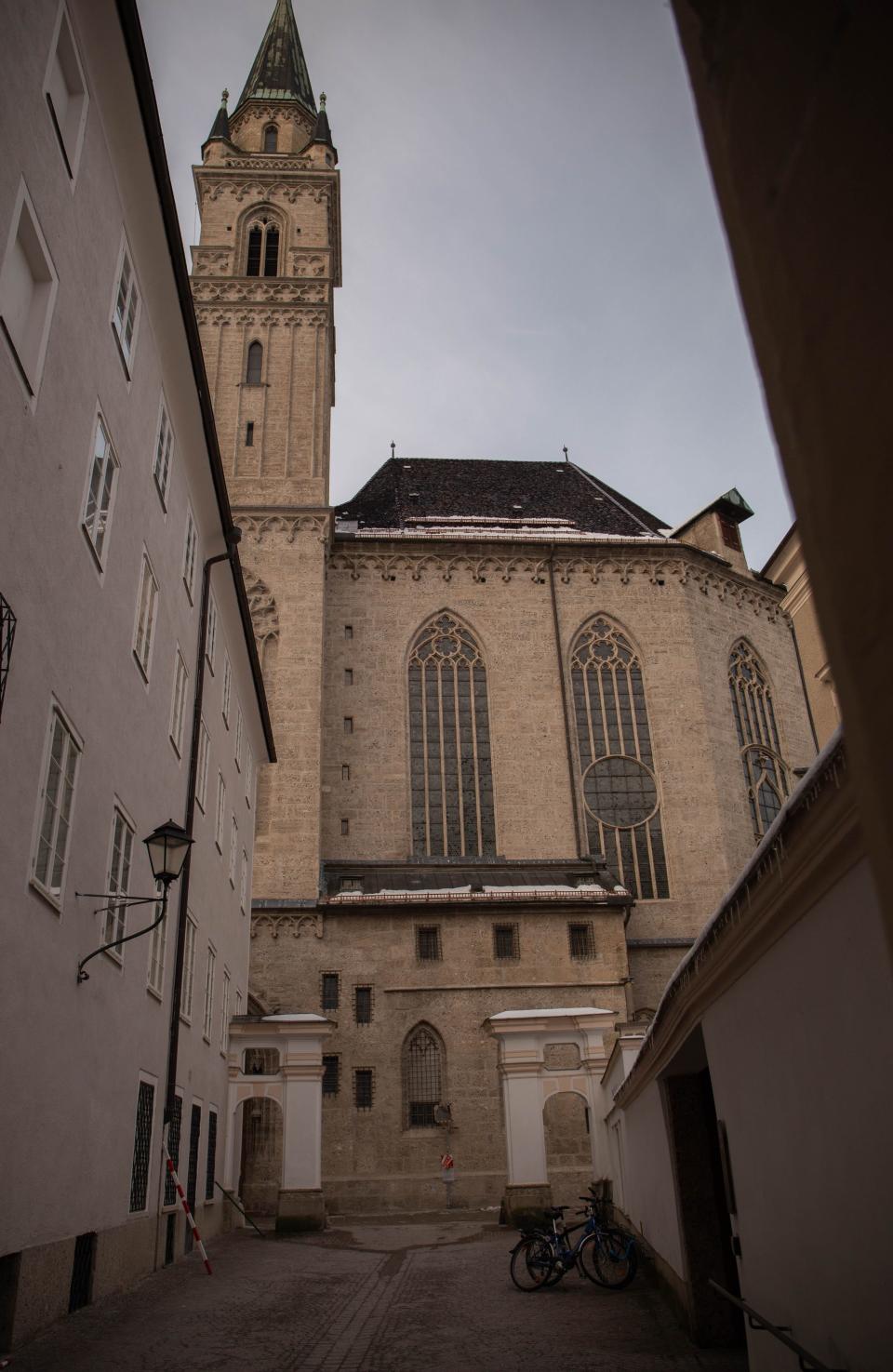
I knew from my first visit that St. Peter Stiftskulinarium isn't visible from the street. Its entrance is located in a tucked-away courtyard inside St. Peter's Abbey.
As I neared the restaurant's location, I saw a beautiful church with a stunning bell tower, which is St. Peter's Church. St. Peter's Abbey, which houses the restaurant, is an extension of St. Peter's Church.
Apple maps led me to an archway of a large pink and cream fortress.
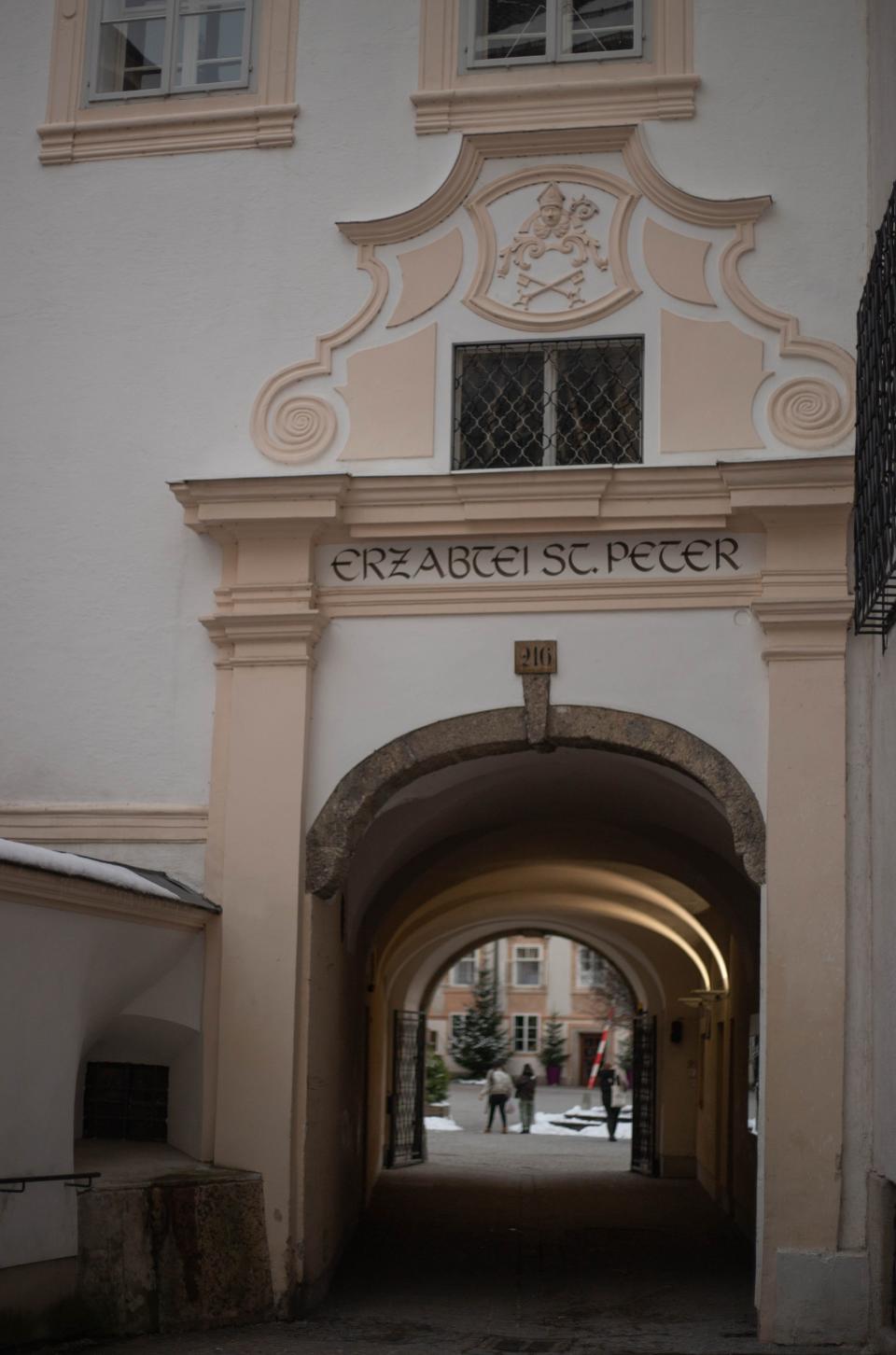
The first time I walked to this restaurant, I was skeptical that it was located through this archway, since it seemed an unlikely place for a restaurant.
The second time I visited, I was so excited to walk through the archway again knowing what was on the other side.
The archway opens into the abbey's beautiful courtyard.
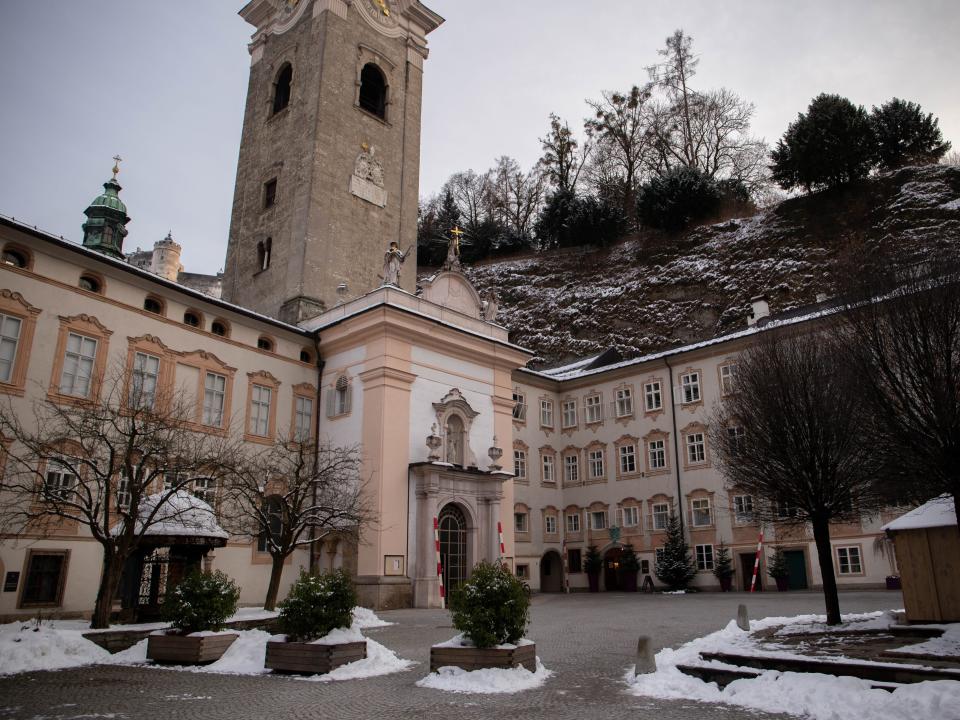
The archway leads into a beautiful courtyard surrounded by an enormous pink and cream-colored fortress on all four sides. This building is St. Peter's Abbey and Monastery, and the restaurant is located inside.
The abbey and monastery were built into the Mönchsberg mountain during the 7th century. I didn't know this the first time I walked into the courtyard, so I was surprised to see what looked like rocky cliffs directly above it.
Across the courtyard, I saw a turquoise plaque with the number 803, the year the restaurant was established.
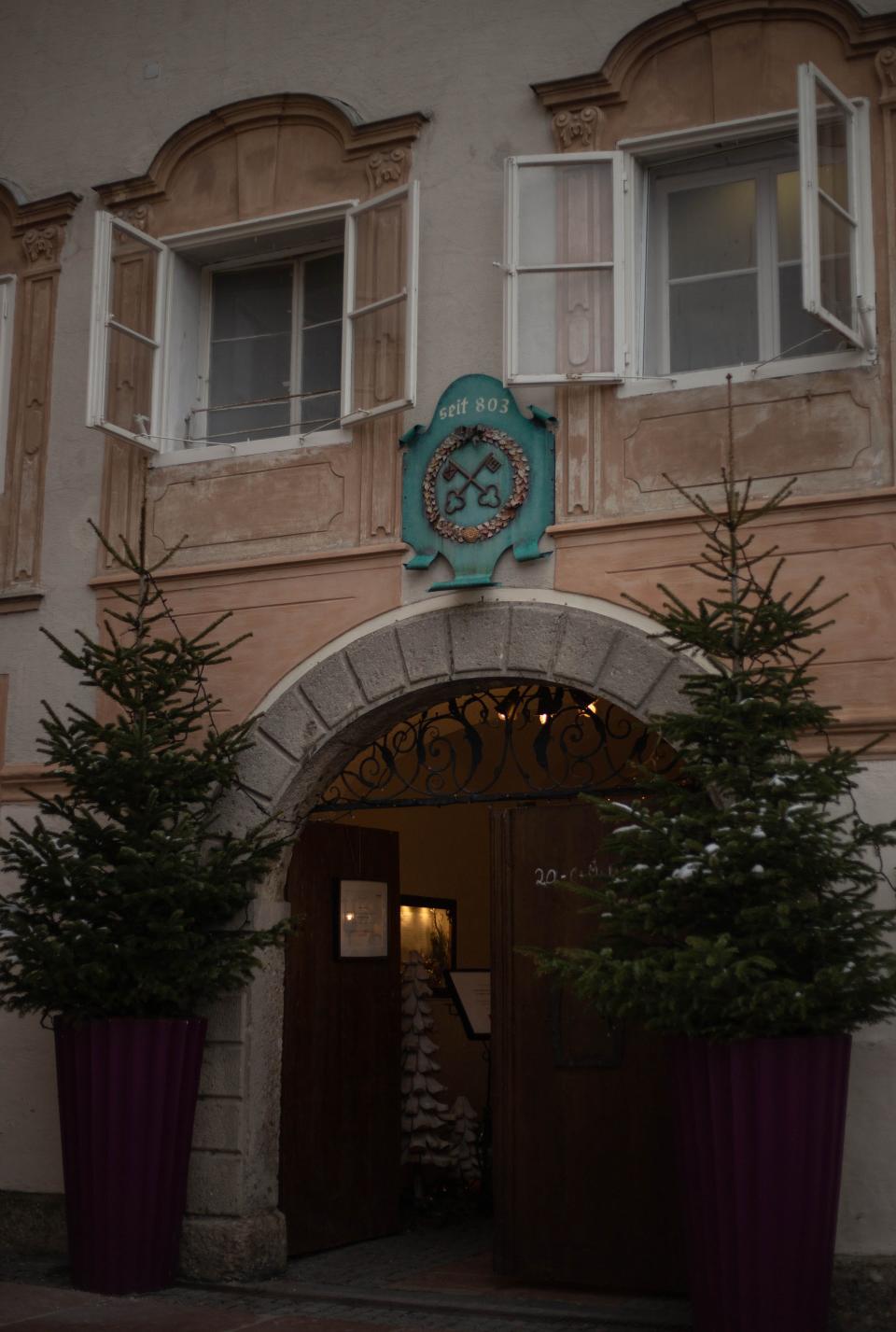
The walk across the courtyard to the restaurant felt suspenseful.
It was hard to believe that I was entering a building that originated in the year 803. When I walked through the archway under the turquoise plaque, I was greeted by a friendly host who walked me to my table.
The restaurant has 11 uniquely furnished and distinct dining rooms.
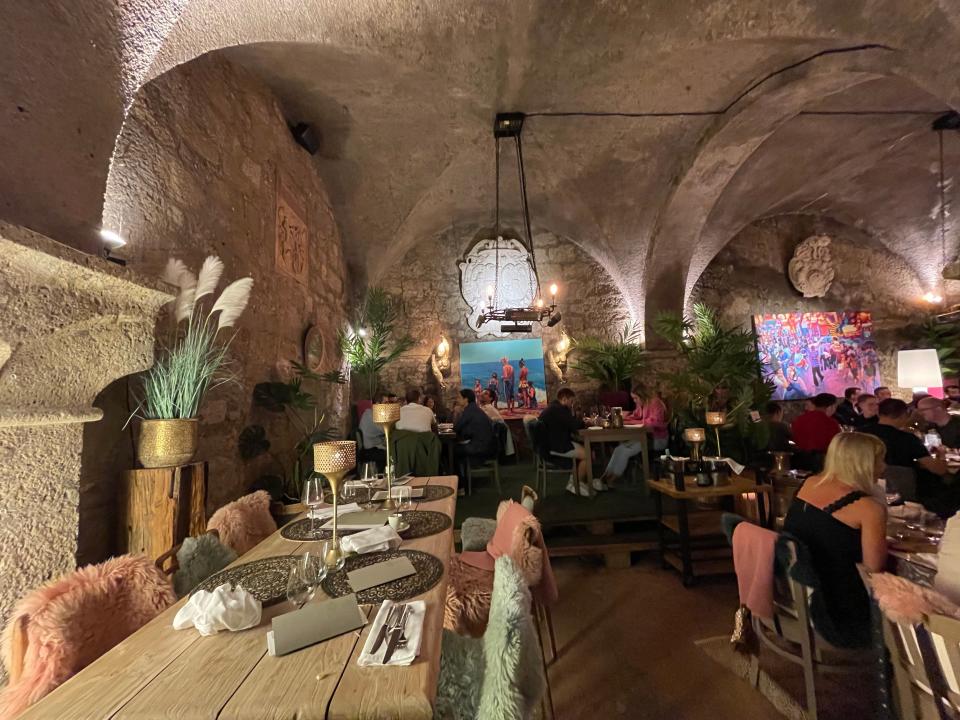
Inside St. Peter Stiftskulinarium, there are 11 different and distinctly-furnished dining rooms.
I find that each of them has its own personality and fascinating story to tell.
The two oldest dining rooms are carved into the stone cliffs under the Hohensalzburg Fortress. The most recently-built dining room was added in the 1600s.
One of the dining spaces is a patio lounge. I think it's a hip spot for outdoor dining with a funky nightlife vibe.
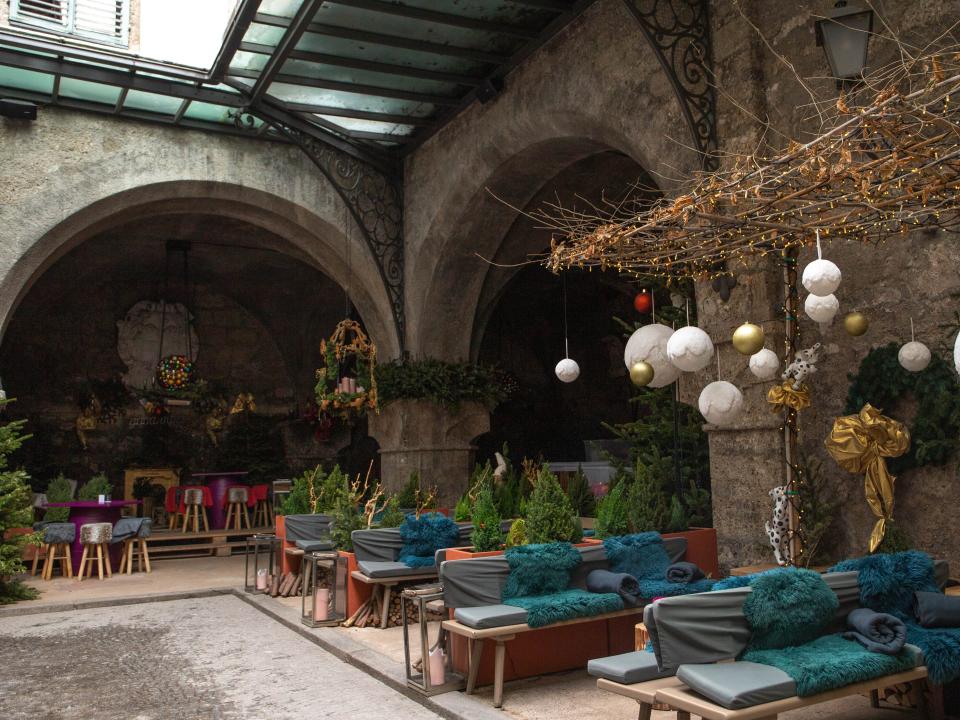
Upon entering the restaurant, the first thing I saw was a beautiful outdoor patio lounge that I learned it was once the abbey's entry courtyard for monks and religious travelers.
I sat in this lounge area during my first visit in the fall and loved the look of it, with comfortable couches, benches, and chairs covered in colorful, textured throw blankets, faux fur, and pillows.
It reminded me of a hip, upscale New York City bar — and also an ancient church.
The most recent time I ate here was in winter, and the patio decor appeared whimsical with Christmas trees, twinkly lights, and other festive fixtures.
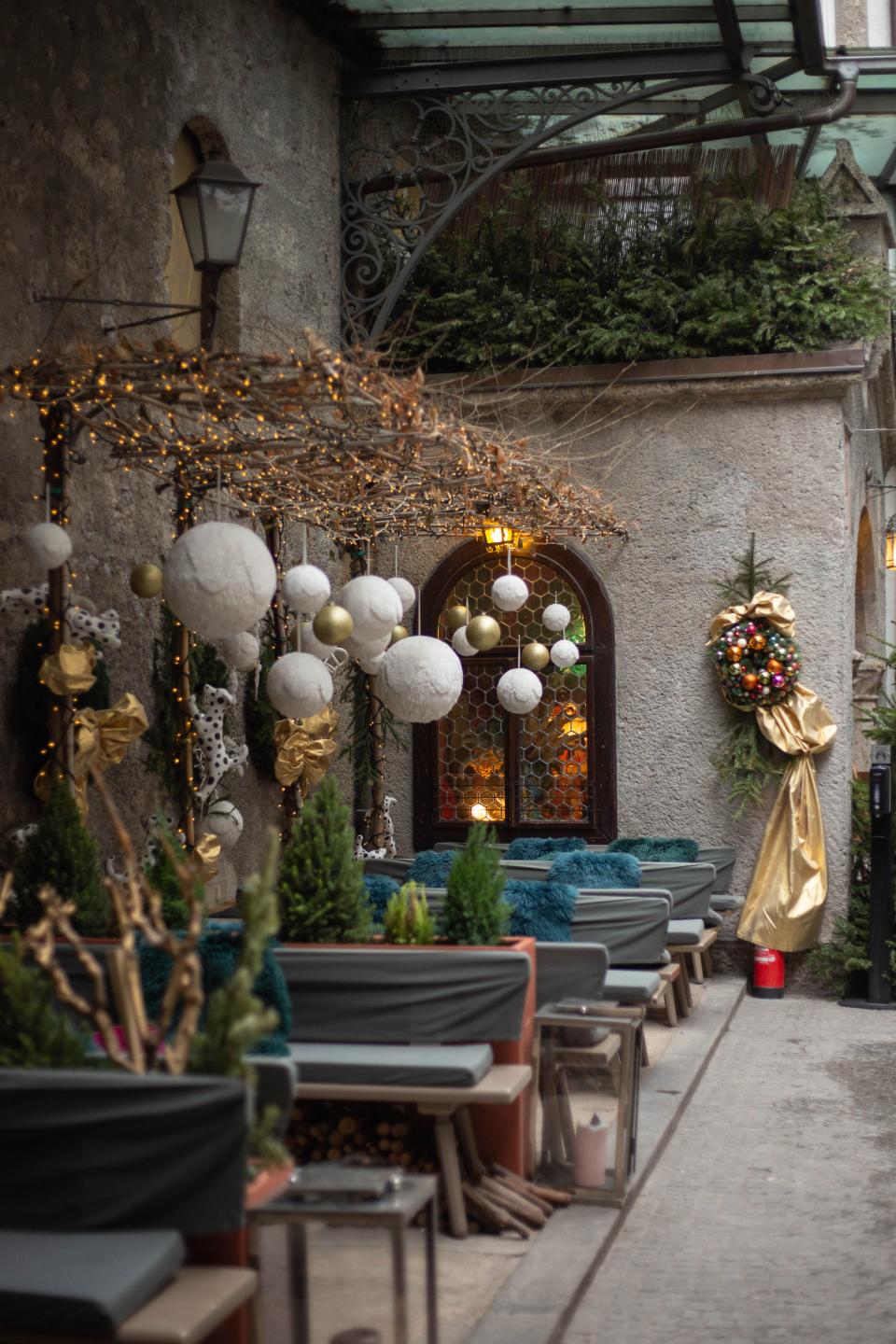
When I first ate on the patio, the decor felt summery with neon lights, straw light fixtures, and jungle-themed art.
But when I returned in winter, the look was updated to reflect the new season. I thought the changing design kept the restaurant feeling fresh and exciting.
Inside, I find the interior design to be eclectic, yet elegant.
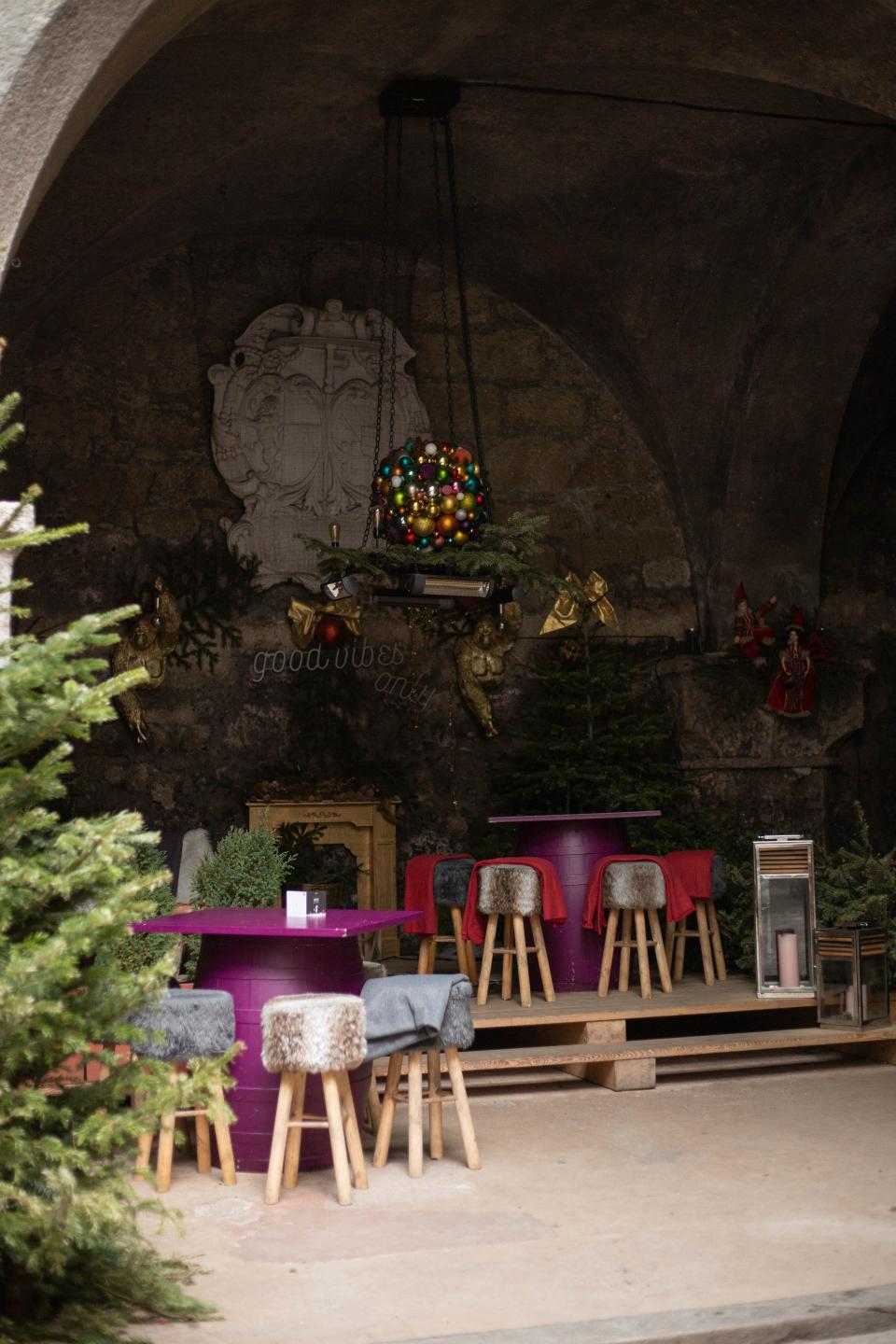
Claus Haslauer and his wife Veronika Kirchmair-Haslauer signed the first-ever lease for the restaurant in 1992 at the age of just 25. Veronika began a design transformation of the restaurant space in 1999.
I'm happy that I visited the restaurant during two different seasons. It was obvious to me that the interiors are updated regularly, as well. I was mesmerized by the bold, deep color palette, as well as unique, peculiar artifacts I spotted throughout the restaurant.
While I enjoyed the patio in the fall, for my winter visit, I sat in one of the traditional dining rooms.
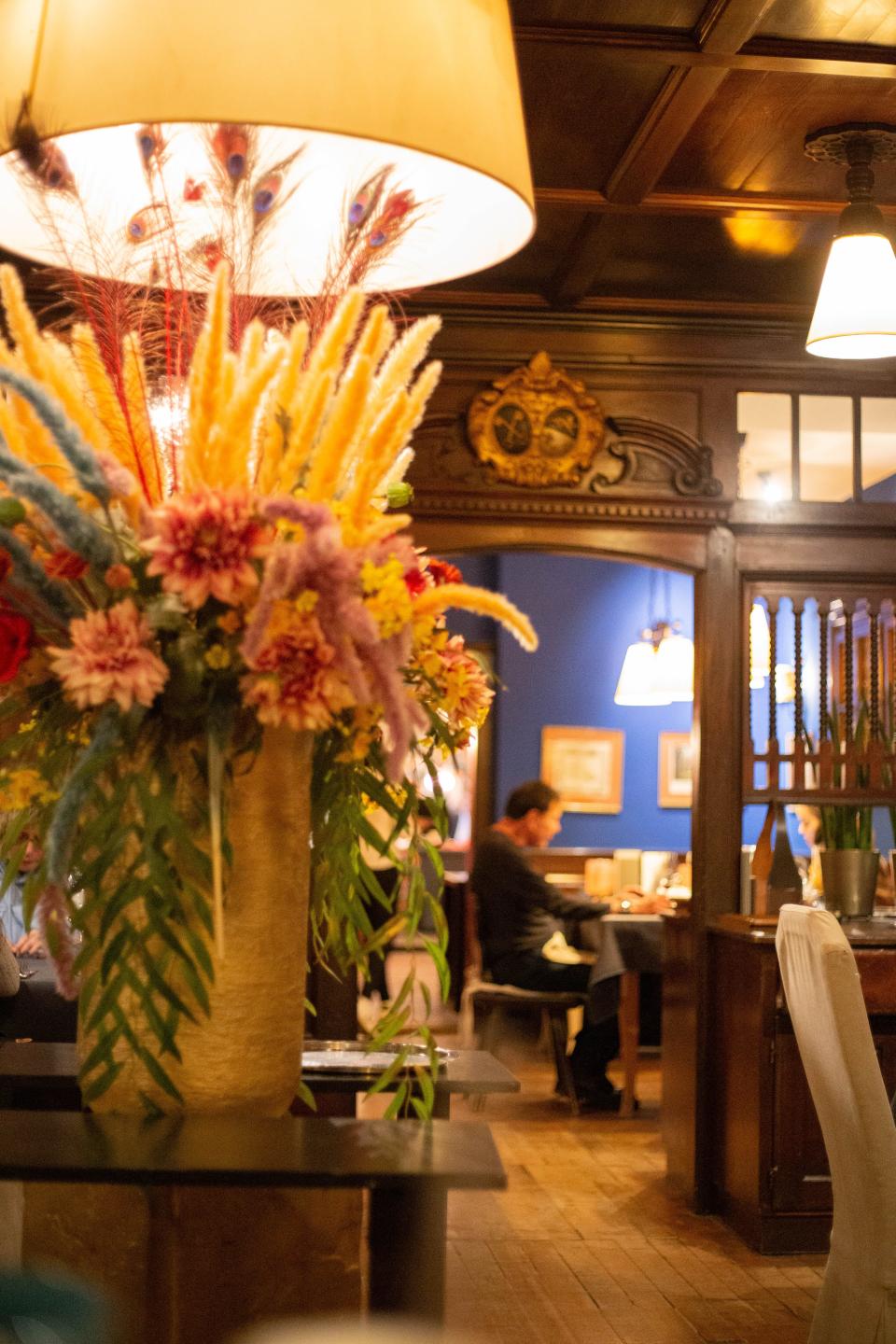
The hostess led me to a table in a dining room called Prälatenstube that holds 24 guests, and is connected to other dining areas.
The walls and ceiling were crafted from dark, polished wood with intricately-carved designs. I liked the deep blue and burgundy accents, and colorful flower arrangements.
I thought this dining room had a quiet, laid-back energy. It didn't look as large compared to some of the other rooms, which I thought made it feel more intimate. My reservation was early in the evening, so there were a few empty tables around me.
Although I really enjoyed my experience in the traditional dining room, next time, I'll go back to the patio where I found the atmosphere to be more lively and exciting.
I started my meal with a cocktail.
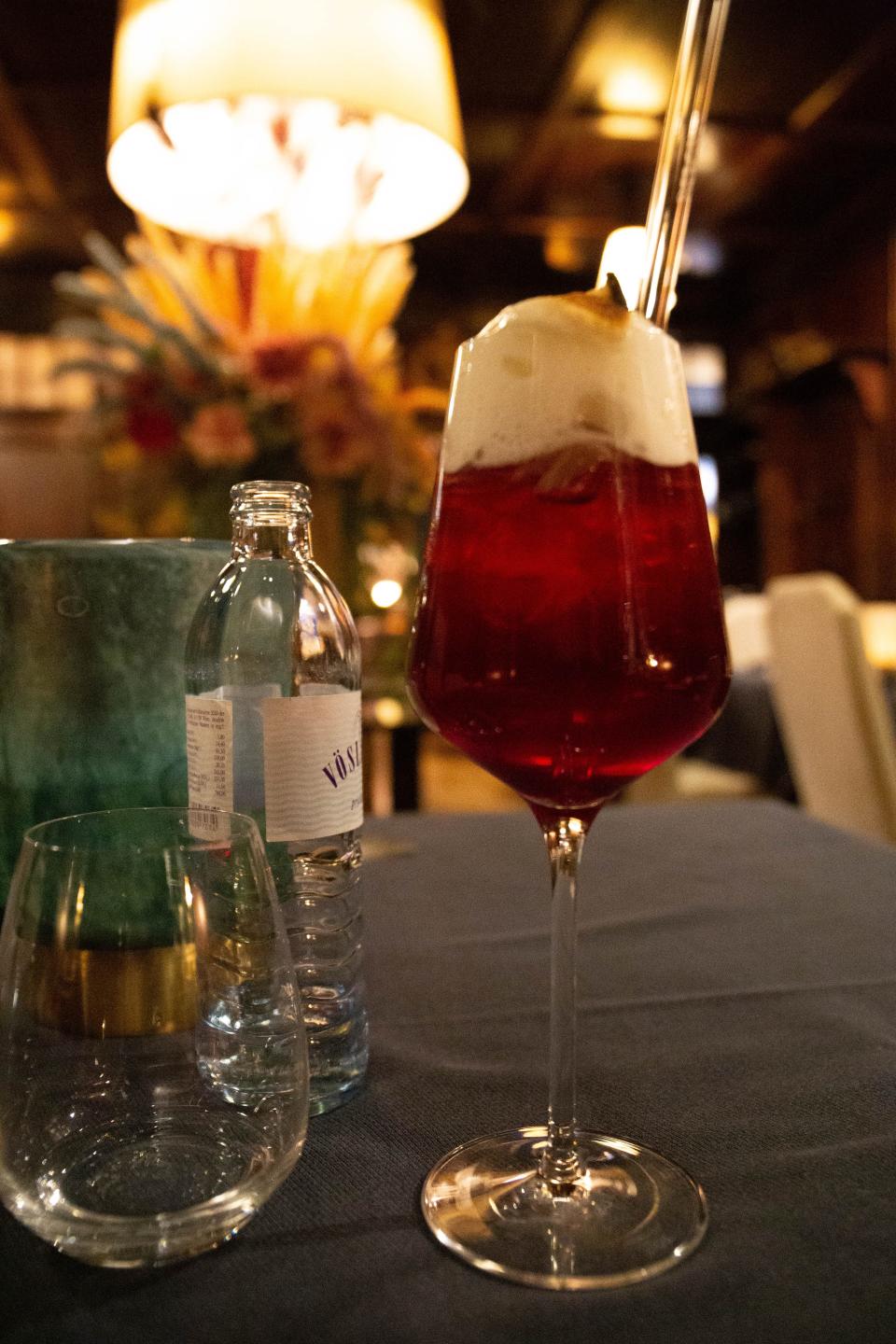
I started my meal with a cocktail I found to be refreshing and not-too-sweet.
Afterward, I enjoyed a glass of Gruner Veltliner, Austria's popular white wine and go-to choice in restaurants. St. Peter Stiftskulinarium has been famous for its wine collection as well; it currently has over 600 wines.
While I waited for my meal, I ate homemade bread.
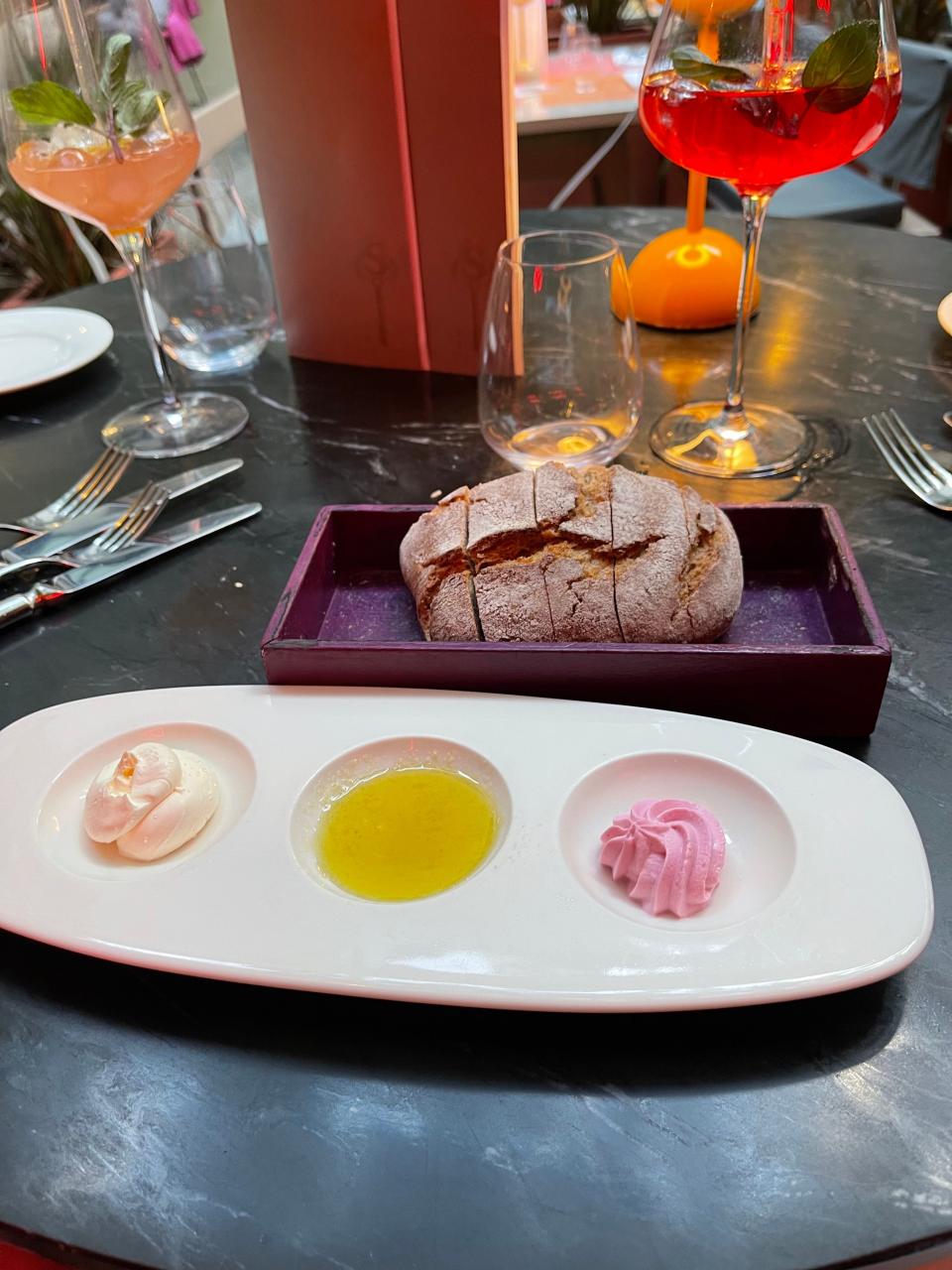
This homemade bread starter came with an extra charge, but I think it's worth it. I thought the bread was warm and delicious with the perfect crunch, and it came with olive, butter, and a second butter made with beets.
I did a quick Google search at the restaurant and was surprised to learn that Austria is known for baking the world's greatest bread beginning hundreds of years ago. Austrian artisan bread later arrived in France and Italy courtesy of the Austrian-Hungarian empire.
For dinner, I ordered the national dish of Austria called Tafelspitz, a beef dish that was plated in front of me.
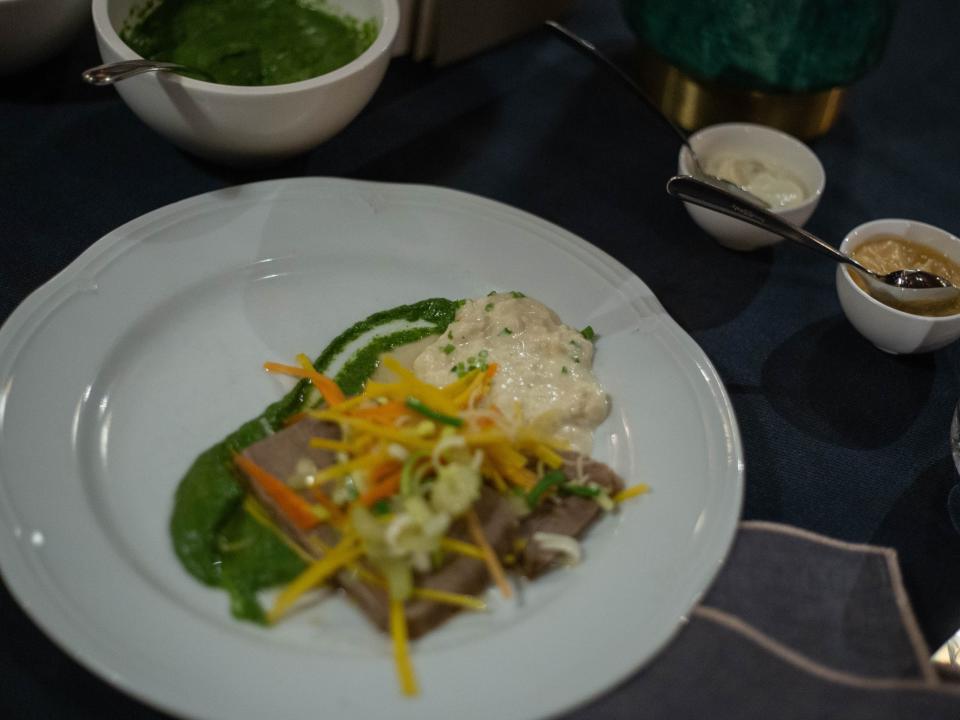
Tafelspitz is beef that is cut from the rump and has a characteristic layer of fat on one side. I ordered this dish because it's one of the most popular dishes in Austria that has been creatively plated in front of customers for hundreds of years.
According to the Austrian government, Tafelspitz may have first appeared in Hotel Sacher in Vienna, sometime around the middle to end of the 19th century.
The beef was cooked in a copper pot with marrow bones, vegetables, and herbs. I thought the flavorful broth was one of the best parts of the meal.
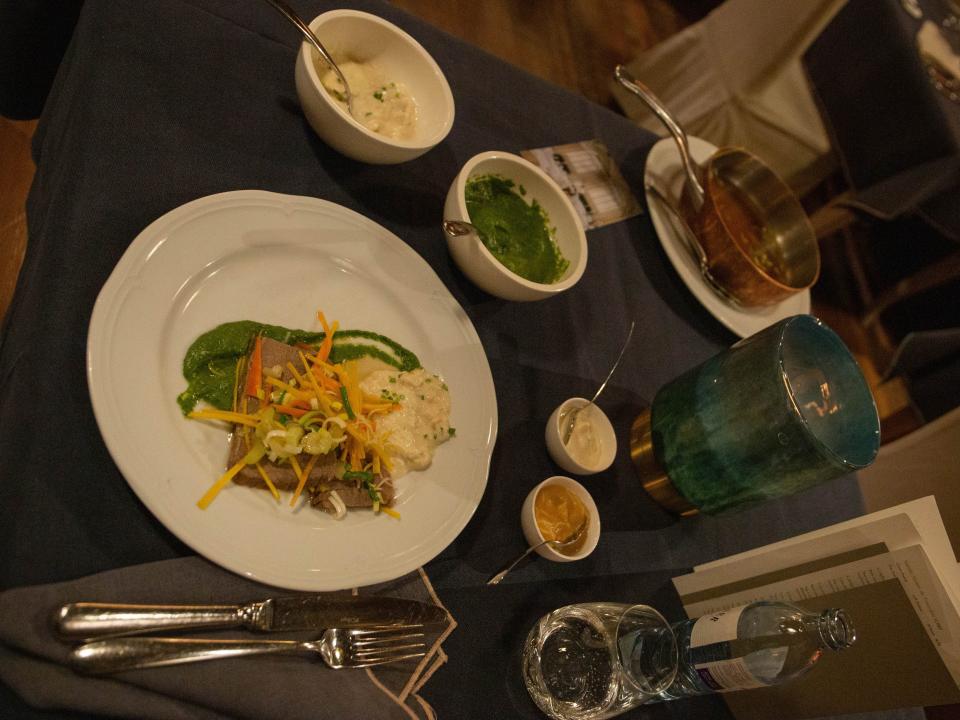
At the table, the server first smeared creamed spinach onto my plate. Next, they served a large spoonful of a thick white sauce made with milk, bread, raw egg yolk, mustard, vinegar, pepper, salt, and a pinch of sugar.
They then placed the meat on the center of the plate, alongside the spinach and white sauce, and covered it with vegetables as well as the broth it was cooked in. I was given two additional sauces to accompany my Tafelspitz — an apple-horseradish sauce and a sauce made with chives.
I ordered Apfelstrudel for dessert, a traditional Austrian apple strudel.
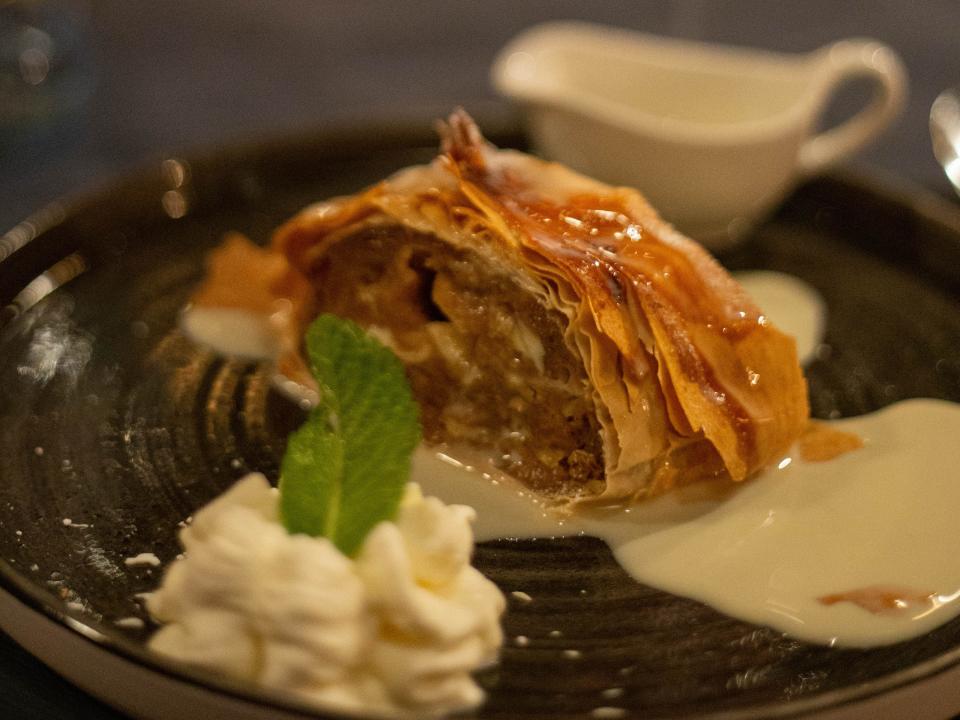
To cap off my meal, I ordered the restaurant's homemade apple strudel.
I thought the pastry shell was flakey and light, and the apple filling was gooey, delicious, and warm. The strudel was served with whipped cream and a rich vanilla sauce, and I ate every last drop.
I liked it a lot, but I plan to order their famous meringue-like dessert, Salzburger Nockerln, the next time I visit due to its high reputation.
The meal cost around €75, which I thought was reasonably priced.
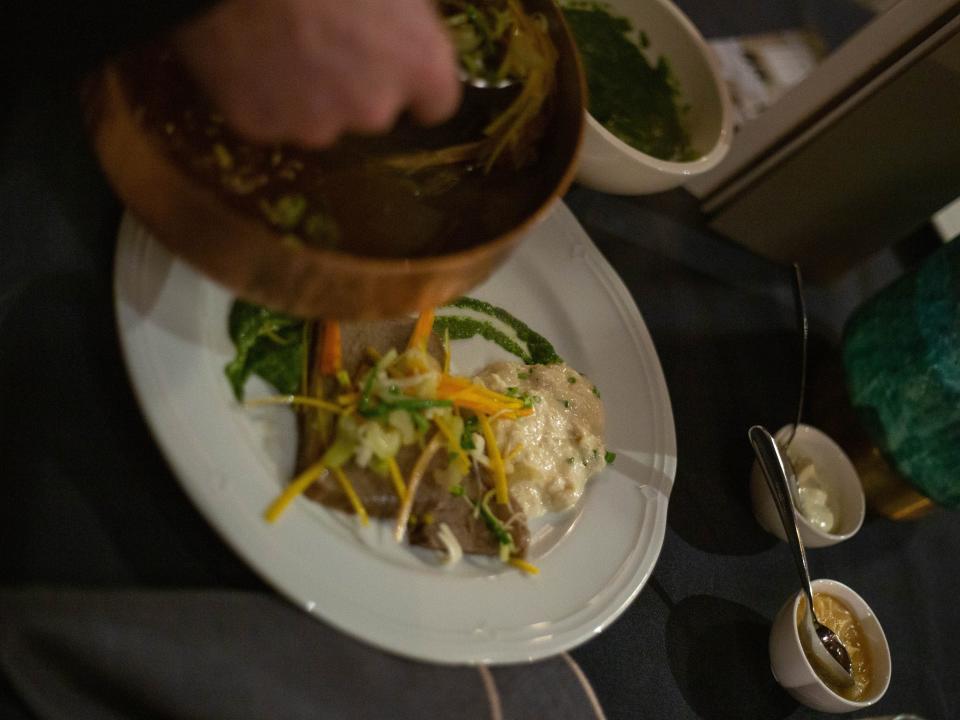
This price, which is about $80 USD included the Tafelzpitz, which was €30, as well as a bread starter, cocktail, glass of wine, and dessert.
I think it was a good value, especially considering the restaurant's ancient history and fame.
After I ate and paid for my meal, I explored the restaurant.
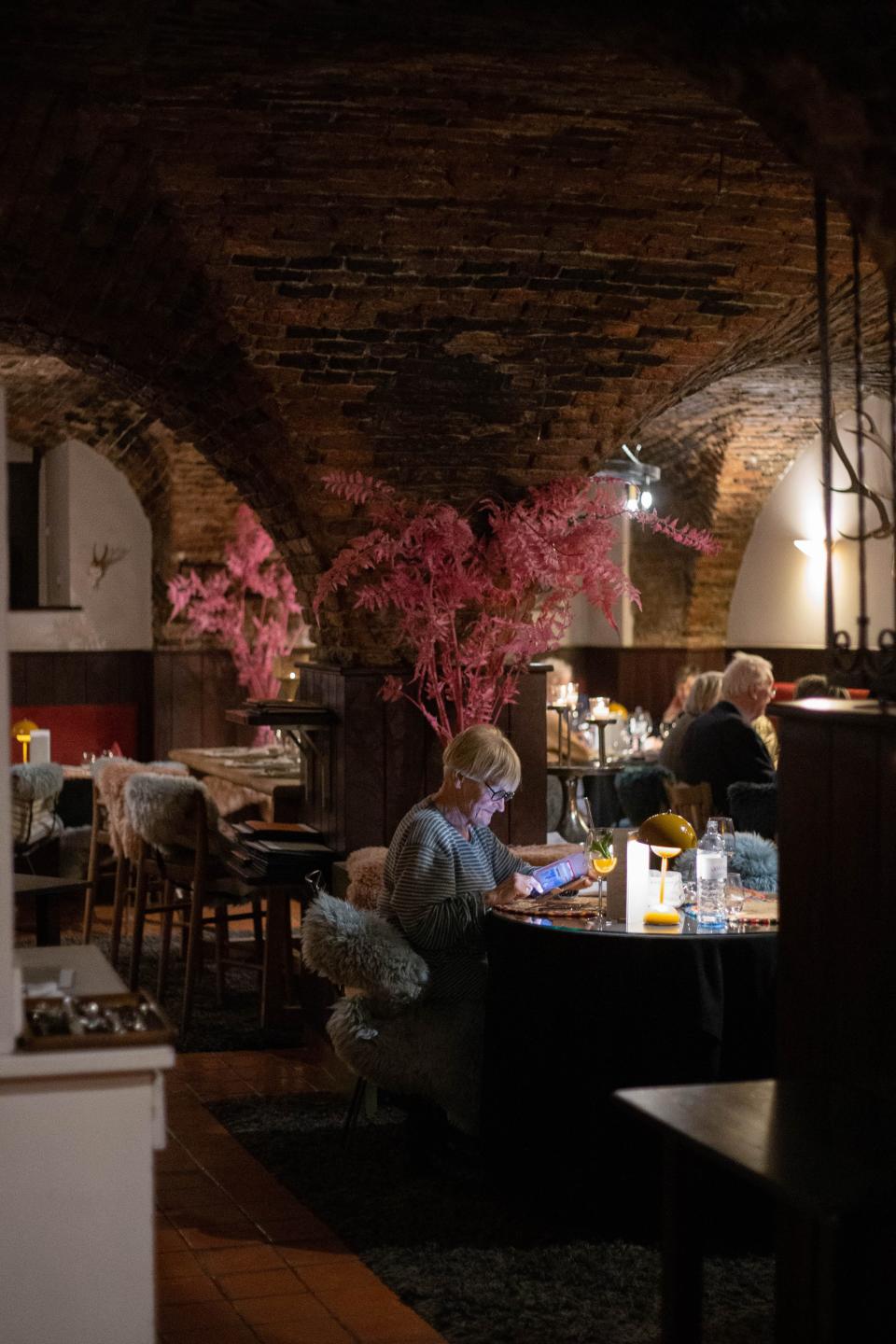
I found myself in Richardstube, which was the monastery's wine cellar 1,200 years ago.
Richardstube is used as a dining room today and is essentially the same as it was back then, except for the some new, trendy decor. I found the ambiance here to be relaxed and intimate.
Overall, I felt an enchanting, almost eerie feeling as I walked around a restaurant that has served generations of people, dating back to the dark ages.
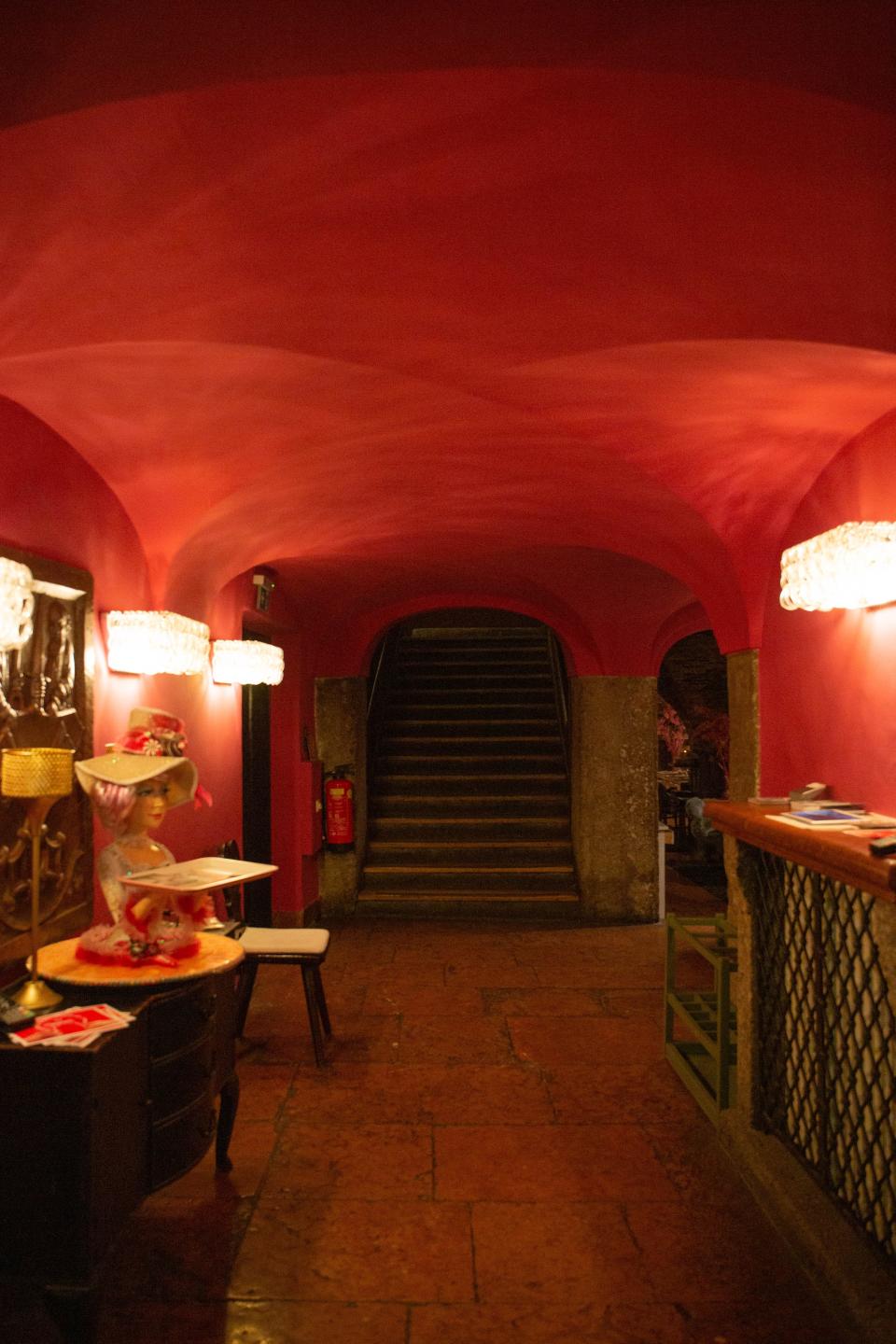
For me, St. Peter Stiftskulinarium evokes feelings of mystery and enchantment. It felt exciting, and like a journey back in time. Some rooms felt crypt-like with ancient stone arches, pillars, and hallways, while others starkly contrasted that feeling with trendy magazine-worthy decor.
Exploring the restaurant after my meal was one of the best parts of the experience.
St. Peter Stiftskulinarium also hosts Mozart dinner concerts, which I'd love to attend next time.
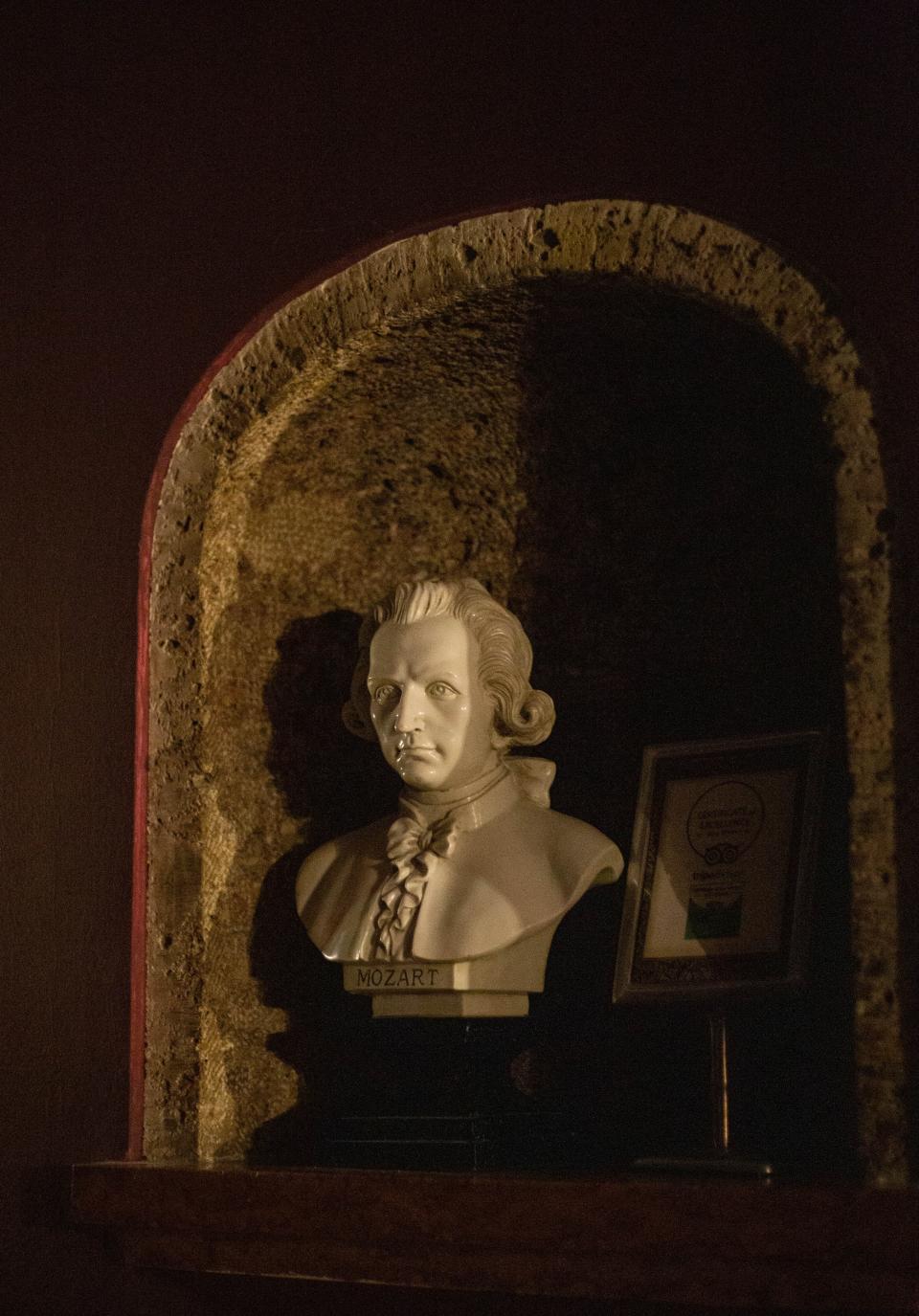
St. Peter Stiftskulinarium hosts Mozart dinner concerts in the restaurant's Baroque Hall, which is one of the only concert halls in Salzburg that is still illuminated by candlelight. The concerts feature costumed music performances and a three-course candlelit dinner based on recipes from the 18th century.
The musical program takes place multiple nights per week, and is performed by Amadeus Consort Salzburg in three parts before and in between the dinner courses. Each part is dedicated to a famous Mozart opera. You must make a reservation to attend.
After two back-to-back great meals, I highly recommend visiting St. Peter Stiftskulinarium.
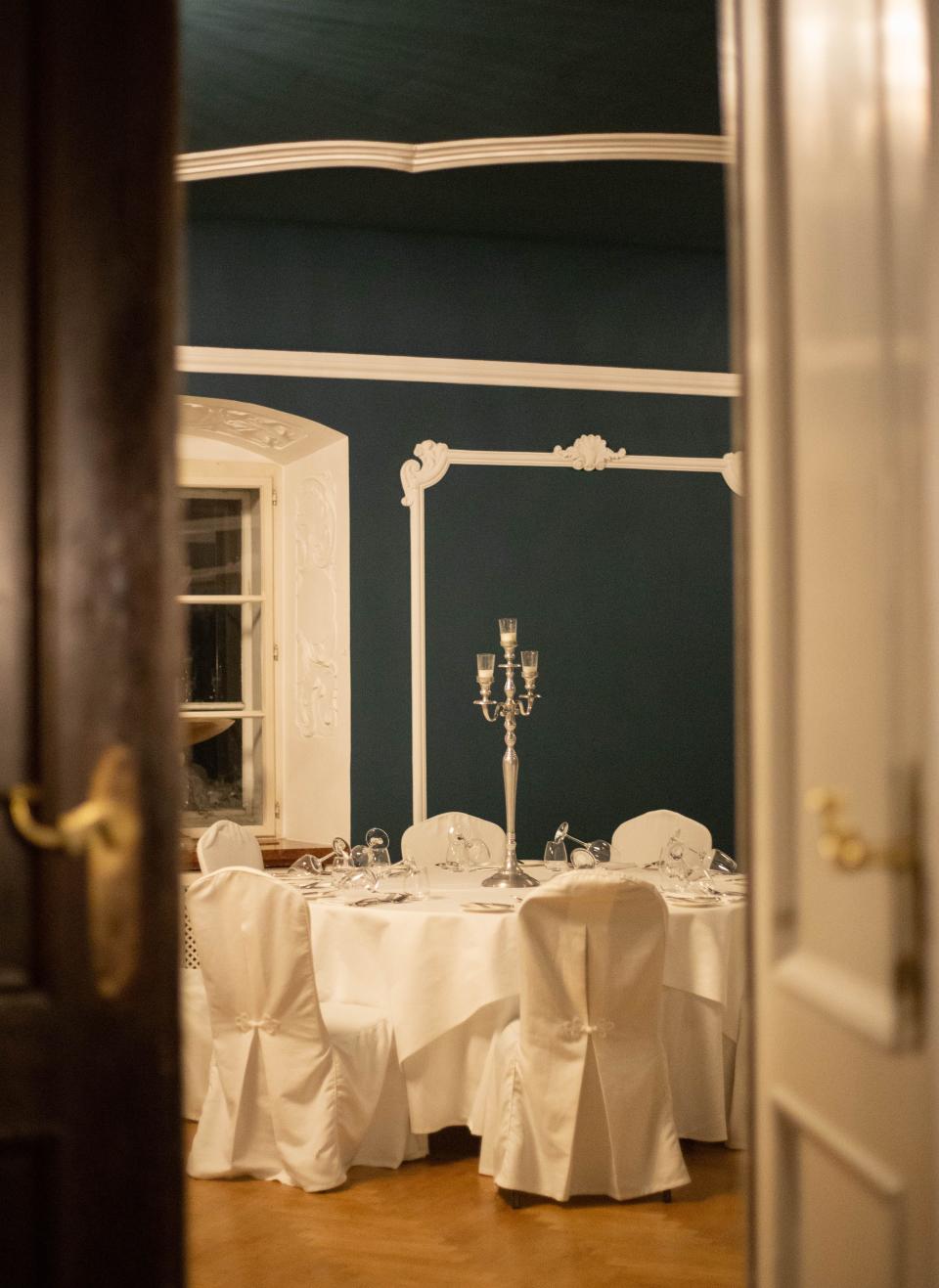
I absolutely loved my experience at St. Peter Stiftskulinarium. The food, drinks, and ambiance were phenomenal, and I thought it was thrilling to experience a piece of ancient history.
I highly recommend making a reservation here while in Salzburg for a great meal and a fascinating opportunity to learn about the history of Salzburg.
Read the original article on Insider

 Yahoo Autos
Yahoo Autos 